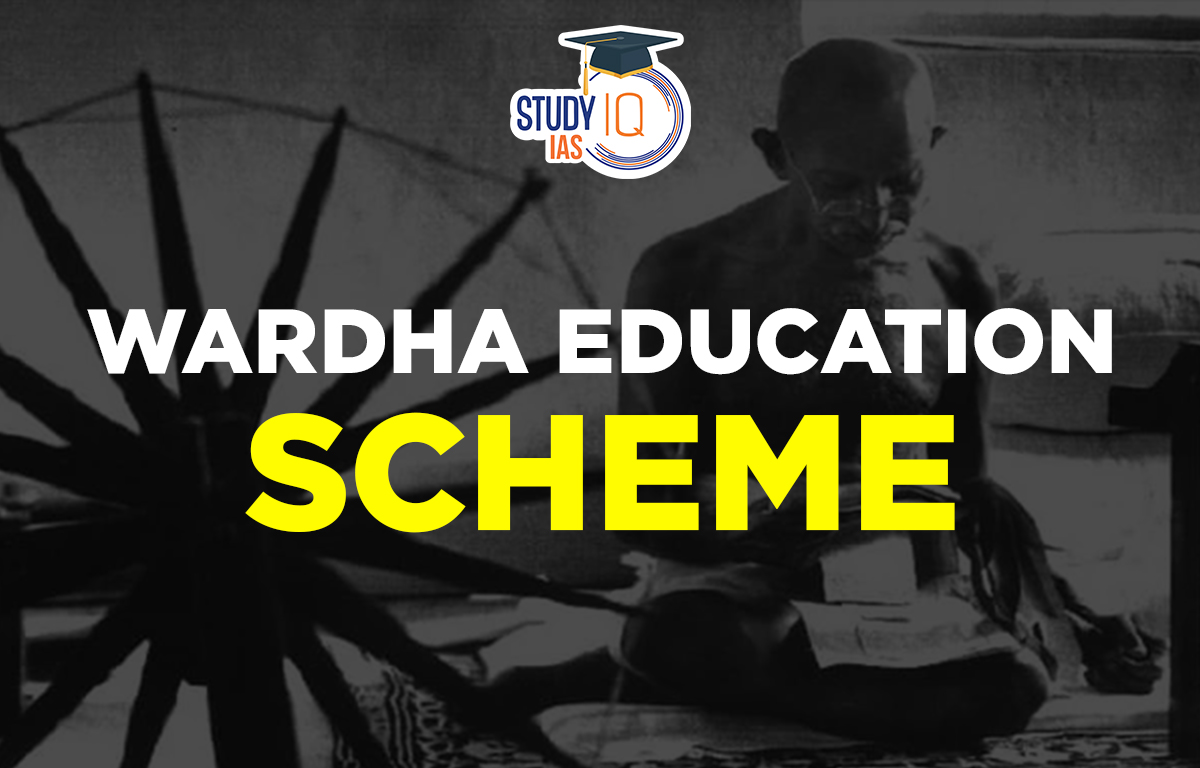Table of Contents
Wardha Scheme
Read complete details about Wardha Scheme. Nai Talim, Basic Education, Buniyadi Talim (Shiksha), and Basic Shiksha are additional names for the Wardha Scheme of Education. The plan was the result of Mahatma Gandhi’s wise planning, who started and supported a number of positive programmes for the population’s economic, educational, and social growth. He believed that education was a powerful tool for reunifying the country. This article has all the details for Candidate of UPSC Exam Preparations.
Read More: Sadler Commission
Wardha Scheme History
In 1937, the Government of India Act, 1935, became operative. In accordance with the Act, Congress Ministries were established in seven Indian provinces. Prior to this, the Congress had made a strong case for universal, free education. The Congress had to put it into practice once it had the authority to do so.
Mahatma Gandhi was well aware of the appalling state of education in the nation. He promoted a primary education program based on Indian traditional culture delivered through mother tongue as a means of addressing this situation. However, this came with a hefty price tag and new taxes. Mahatma Gandhi proposed that the goal of public education need not be delayed due to a lack of funding to resolve this conundrum.
If the process of schooling could be made self-supporting by imparting instruction through a useful and productive trade, free and obligatory elementary education might be provided to every kid. In a series of articles published in “Harijan” on June 31, 1937, Mahatma Gandhi expressed his opinions on education.
These pieces eventually led to the creation of the Wardha Scheme of Basic Education. Mahatma Gandhi’s opinions sparked debates in academic circles. It was therefore advisable to have the programme evaluated by professionals in the field of education. Finally, at the 1937 Wardha Conference, Mahatma Gandhi presented the nation with his Basic Education System.
Read More: Education System in British India
Wardha Scheme Feature
Everyone between the ages of 6 and 14 will get free, compulsory education for 8 years. It did not consider a person’s gender, culture, or religion. However, it was permitted for parents to want their daughters to leave at the age of 12 if they so wished. The first five years were for the junior stage, while the next three years were for the senior stage.
The mother tongue became the primary medium of instruction for delivering education throughout all regions. Recognizing that a stronger educational foundation will result from mother tongue instruction. With no pressure to finish the course or worry about exams, the child was free to learn at his own pace. One of the key elements was the curriculum’s adequate flexibility and the availability of a free atmosphere for the youngster to perform.
The education was to be delivered in conjunction with local productive activities or craftwork. The intention was to use the Samavaaya (Samanvay) integration approach to combine education and a regional craft. It was a career-focused education. The purpose of promoting craft skills was to foster group interaction, develop self-sufficient people, the value of work, and emotional growth.
The primary goal of the self-supporting educational system was to eventually generate enough revenue from the sale of their goods to pay the teachers’ wages. The guiding premise of “The Wardha programme of Basic education 1937” was “Learn while you earn and earn while you learn.”
Other costs associated with the school, such as furniture, books, equipment, and school buildings, were requested to be covered by the state. However, Dr. Zakir Hussain eventually amended this to Partial Self-Support since they didn’t want to lose sight of the original goal, which was to spread education throughout the nation.
Read More: Raleigh Commission
Wardha Scheme Objective
It was a really wise choice to develop educated, self-reliant people in India’s cities and villages. It was directed towards an unequal society. It was moving toward national integration by reducing barriers caused by the English language and providing instruction in the mother tongue.
Additionally, it was admirable that improvements could be included at any time for the betterment of the system, and most crucially, religious education had no role. Gave a good mix of academic and practical knowledge. The issue of unemployment and the gap between the educated and uneducated classes may have been resolved by earning money for self-education.
Read More: Hunter Commission
Wardha Scheme Shortfalls
The detrimental psychological impact was disregarded as children worked and studied at the same time. Between those who are formally involved and those who are not, there is a lack of cooperation inadequate availability of qualified teachers with knowledge. This was a significant factor in the Basic Education Scheme’s failure.
It was difficult to find a connection between academic courses and handicrafts, especially at a time when fast industrialization was imperative. Instead of acquiring knowledge, craftwork had become the main priority. Some people even expressed concern that it was converting the school into a tiny business. In 1939, shortly after the Wardha Scheme, World War II began. Ministers of the Indian National Congress also quit in opposition to the British.
Read More: Macaulay Minute
Wardha Scheme Advantages
It is desirable psychologically because it frees the child from the oppression of a solely academic and theoretical education that its active nature is constantly mounting a healthy protest against. It strikes a balance between the intellectual and practical aspects of experience and can be used as a tool to teach the body and the mind to work together.
In a developing nation like India, where roughly half of the world’s illiterate people live, the programme is both financially sound and acceptable. It facilitates the rapid expansion of elementary education while putting less strain on the public purse. The plan, when executed wisely and effectively from an economic perspective, will boost our employees’ capacity for production and provide them more freedom to make the most of their free time.
Making a significant craft the foundation of schooling can, from a strictly educational standpoint, provide children’s knowledge more concreteness and reality. The various facets of life will then be associated with one another, and knowledge will become related to life.
Read More: Hartog Committee
Wardha Scheme Limitation
Cognitive, emotive, and native aspects make up human nature. The Wardha Scheme places a strong emphasis on the final element in the vain hope that the student will haphazardly receive training in the first through his preparation for the last. The middle component is entirely disregarded.
It is impossible to make a natural connection between craft and all the culturally significant disciplines that a reasonable educational system would include in its curriculum. Concrete instruction that is based on the child’s active participation in his environment is best. But to hang all of knowledge on the hook of a single craft is illogical.
“Education fit for our nation’s talent should have a clear theological foundation and a deep disdain for materialistic pursuits. Craft-centered education is clearly at odds with our long-standing beliefs.
Read More: Wood’s Despatch
Wardha Scheme Basic Education
Gandhi was a staunch experimentalist and a realist when it came to education. His investigations into truth and education served as the means by which he was able to realize his personal goal. He attempted to apply his philosophy to accomplishing the evolution and establishment of an ideal society in a number of his educational endeavors. The dynamic aspect of his entire concept is his educational method.
Since “Basic” comes from the term “base,” which denotes the base or foundation of something on which the entire thing relies or is built to stand, Gandhi aimed to strengthen the educational building’s base. He proposed this plan in order to achieve this goal. This educational program is centered on India’s native culture and civilization.
By allowing him to use his newly learned information and abilities in real-world situations, it tries to help a youngster become independent. Since the child is the centre of education, basic education is closely related to basic needs and interests.
Read More: Government of India Act of 1919
Wardha Scheme Basic Education Failure Causes
In the academic community, the Basic Education’s self-supporting component faced harsh criticism. Teachers, community leaders, and educational administrators had exhibited a lack of interest in it. It was stated that the programme transforms a school into a hub of small business. Additionally, teachers were reliant on students’ salaries. This demoralised the teacher-student connection.
Liberal education had been neglected as a result of an excessive focus on craft. The craft is frequently not chosen appropriately in terms of education and societal relevance, and teaching through craft has just become a catchphrase.
Basic Education was also criticized for relying too heavily on a particular craft, which was another point of contention. It might not promote liberal education, which would lead to an imbalance between intellectual and vocational education in the educational system.
Wardha Scheme UPSC
The Wardha Scheme of Basic Education was the consequence of Mahatma Gandhi’s realization of India’s non-effective education system. In 1931 Mahatma Gandhi for the first time attended the Second Round Table Conference (RTC) in London, where he highlighted the deterioration of the education system in India and held British education policy responsible, for the severe downfall of education in India. Read all about Wardha Scheme for UPSC Exam Preparations.


 Nagari Pracharini Sabha Revival: Backgro...
Nagari Pracharini Sabha Revival: Backgro...
 Ryotwari System in India, Features, Impa...
Ryotwari System in India, Features, Impa...
 Battle of Plassey, History, Causes, Impa...
Battle of Plassey, History, Causes, Impa...





















